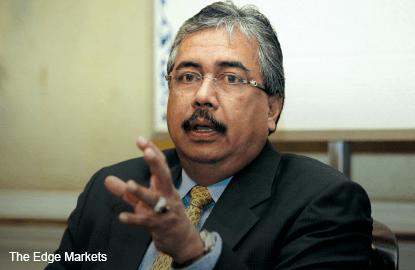
This article first appeared in The Edge Malaysia Weekly, on January 11 - 17, 2016.
 IT is apparent that the plantation sector is experiencing harsh conditions due to soft crude palm oil (CPO) prices and low production caused by a dry spell.
IT is apparent that the plantation sector is experiencing harsh conditions due to soft crude palm oil (CPO) prices and low production caused by a dry spell.
TH Plantations Bhd (THP), like other companies in the industry, is mired in a tough operating environment. In fact, the group is scaling back its targets for its key performance indicators (KPIs) this year, but declines to provide the specifics.
“It does not seem like we will be able to meet our initial yield target for 2015. Nevertheless, our total production in 2015 is still 3% to 5% higher than our 2014 production,” CEO and executive director Datuk Zainal Azwar Zainal Aminuddin tells The Edge.
“The prolonged dry weather seen in the first half of last year and the adverse wet weather at the end of 2014 had a deeper effect on the group’s production than initially expected,” he says.
THP, in which Lembaga Tabung Haji holds a 72% stake, is likely to miss its targeted yield of 21.15 tonnes of fresh fruit bunches (FFB) per hectare for 2015 by quite a bit.
For the first nine months of last year, the group recorded an average yield of only 13.28 tonnes per hectare, with 578,788 tonnes of FFB in total.
“We are expecting yet another tough year and we are anticipating the onset of some impact from El Niño on our production, although this is difficult to quantify at this juncture. For 2016, we are targeting a growth of 5% to 10% over 2015 production,” says Zainal.
If the existing production data is annualised, a back-of-the-envelope calculation shows that this may not even touch 20 tonnes per hectare.
Due to the weaker production and commodity prices, THP’s financials have taken a hit. For the third quarter ended Sept 30, 2015, its net profit halved to RM6.2 million from RM12.2 million the year before while revenue was flat at RM133.5 million.
 For the nine months ended Sept 30 (9MFY2015), net profit fell 53% year on year to RM17.9 million and revenue slipped 16.4% to RM326 million.
For the nine months ended Sept 30 (9MFY2015), net profit fell 53% year on year to RM17.9 million and revenue slipped 16.4% to RM326 million.
For the cumulative 9MFY2015, sales volume for FFB fell over 14% y-o-y and that for CPO decreased 3.8%. The impact on THP’s bottom line was exacerbated by the drop in selling prices by 11% for CPO and 18.5% for FFB to RM2,086 and RM374 per tonne respectively.
While the impact of bad weather on FFB production may, to a large extent, be beyond THP’s control, the group has put aside RM1.5 million to improve its oil extraction rate (OER) over 2015 and 2016.
The initiatives include the upgrading or replacement of its milling machinery and improvement of its quality control practices in the estate.
“With the improved milling efficiency, lower losses during processing, increased volume of mature areas, good practices and quality control in the estate operations, we can expect a gradual increase of 0.25% to 1% towards a significant improvement in the OER for the next few years,” says Zainal.
The group’s OER has seen little change for the last few years, coming in at 20.19% in 2014.
In the meantime, THP will likely revise downwards its landbanking target as it is watchful of its gearing levels, says Zainal.
As at September 2015, its cash stood at RM113.8 million while it racked up a net debt of RM1.14 billion. Its gearing is currently at 0.94 times, a number the company would like to maintain or reduce. It is capping its upper limit at one times.
Three years ago, THP set its landbanking KPI to acquire 30,000ha in Sarawak and Kalimantan, Indonesia, by the end of FY2015. It achieved 60% of the target before purchases stalled last year, causing it to miss its target.
“Our focus at the moment is to consolidate our existing landbank and develop the available green fields,” Zainal says, adding that the group will still keep a close eye on appropriate acquisitions.
THP’s bright spot
Even though the group may not be expanding its landbank, it has a young palm profile and this is in its favour. Its oil palms have an average age of 11 years, including all immature palms.
THP has a total landbank of 104,770ha as at Jan 1, 2016, of which 45% or 47,147ha have matured. The immature acreage makes up 13% or 13,620ha. It is currently in the course of planting another 7% or 7,334ha.
The group is allocating RM18 million to capital expenditure this year to replant a total of 2,700ha of old palms.
“In 2015, about 15,800ha of planted oil palm area was immature, or about 15% of total land area. In 2016, about 3,800ha of planted oil palm area will come into maturity, bringing down the immature oil palm area to about 12,000ha or about 12% of total land area,” says Zainal.
He adds that the additional 3,800ha coming into maturity this year is conservatively estimated to contribute RM20 million to RM25 million to THP’s revenue, and this sum will grow incrementally as the palms approach their peak yield.
Analysts covering THP have a consensus target price of RM1.41 on the stock, indicating a 10.2% upside from last Friday’s close of RM1.28. Of the eight analysts covering the counter, 60% have “hold” calls while 20% say “buy” and 20% advise “sell”.
Save by subscribing to us for your print and/or digital copy.
P/S: The Edge is also available on Apple's AppStore and Androids' Google Play.